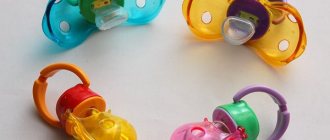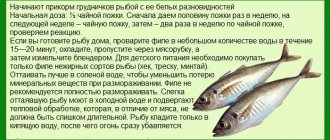Should you accustom your child to a pacifier: pros and cons
The sucking reflex is the most important skill that a child needs for survival, as it provides nutrition, and for establishing a strong psycho-emotional connection with the mother.
If the baby is breastfed and sucks on his mother’s breast at the first request, then the sucking instinct is fully satisfied, so he does not need a pacifier. In addition, many natural scientists themselves are beginning to abandon this device.
Another thing is a baby on artificial feeding or a baby who receives mother's milk by the hour. These babies need a pacifier because their need to suckle at the breast is partially or not met at all.
Some physiological experiments have shown that when weaned from the mother's breast, babies' heart rates begin to increase. But if at this moment you offer them a pacifier, the heart contractions will gradually return to normal. This happens because a pacifier relieves stress and suppresses the expression of negative emotions.
Thus, experts, answering the question of why it is necessary to use a pacifier, give the main argument - the child calms down and quickly falls asleep due to the complete satisfaction of the sucking reflex.
Pros of using a pacifier
Stimulating vital unconditional reflexive behavior is not the only benefit of using pacifiers. According to the beliefs of some experts, a pacifier can perform several useful functions, among which are the following:
- assistance in preventing colds during the cold season;
- regulation of feeding schedule;
- prevention of thumb sucking;
- falling asleep faster and prolonging restful sleep;
- reduction of pain during teething;
- prevention of sudden infant death syndrome due to the fact that the tongue does not sink;
- reduction of negative feelings in painful conditions;
- stimulation of the release of gases from the gastrointestinal tract, which helps relieve the child from colic;
- improvement of bite when choosing a special orthodontic attachment.
Many parents note that the use of this hygienic device allows them not to worry about the fact that a baby who has learned to walk will pick up various dirty objects in the sandbox or just on the street and put them in his mouth.
Disadvantages of using a pacifier
It is possible to accustom a baby to a pacifier, but many experts argue against this process, since the benefits of sucking can be outweighed by negative consequences.
Experts attribute the following aspects to the negative aspects of using pacifiers:
- incorrect selection of pacifiers can lead to malocclusion;
- sucking on a hygienic device can provoke the child to refuse the breast, which will ultimately result in a transition to mixed or artificial feeding;
- a child who is accustomed to a pacifier is more likely to be at risk of contracting infectious diseases of the mouth;
- formation of the habit of sucking a pacifier, as a result of which parents have to wean themselves off the pacifier;
- grasping a pacifier with your lips is different from sucking a breast, as a result of which the mother may feel discomfort when feeding the baby;
- inhibits the child’s development, the child’s interest in the world around him decreases.
The question of whether a child needs to be accustomed to a pacifier is decided solely by the parents, based on the recommendations of the pediatrician. A thoughtful and balanced decision will allow you to avoid the negative consequences described above.
Doctor Komarovsky's opinion
TV doctor E.O. Komarovsky, widely known and respected by mothers, is convinced that the positive and negative properties of pacifiers are overly exaggerated. The main principle of their use, according to the pediatrician, is mandatory compliance with hygienic requirements.
However, Komarovsky does not recommend accustoming a child to a pacifier if a woman has certain problems with the volume of milk secretion. The baby, distracted by the pacifier, will have less intense influence on the mother's nipples, which can lead to suppression of lactation.
But another situation should be taken into account - when the child is literally hanging on his mother’s breast, trying to realize his sucking reflex. In this case, a pacifier will allow the mother to free up some time and ensure peace in the house.
When to use a pacifier
How to accustom a child to sucking a pacifier, parents need to decide on their own, based on the individual characteristics of the character and behavior of the baby. Pediatricians who do not take a categorical position on the use of pacifiers.
They agree that it is most rational to offer it to a child if:
- the little person is full (he just ate, for example), but continues to open his mouth and tries to put various objects into it;
- the child is bottle-fed from the first days of life;
- a neurologist has diagnosed the child with increased excitability (such a diagnosis can only be made by a pediatric specialist based on test results and a full examination of the child);
- he suffers from excessive accumulation of gases in the intestines or severe colic;
- he was born prematurely (for such children, the pacifier is an additional way to strengthen the jaw muscles and develop the sucking reflex);
- it is planned to leave him without a mother for a long time (the pacifier gives the child a feeling of calm, which will help him cope with longing for the person closest to him);
- the baby must be reassured during prolonged crying or hysteria (for example, when undergoing tests or at an appointment with a doctor conducting an examination using various instruments);
- it is necessary to distract him (especially important for mothers of twins, when it is necessary to calm one of the children while feeding the second).
Optimal age for training
Another common question that mothers ask themselves and experts concerns the age at which a child can be given a pacifier. The answer will again depend on the type of feeding.
So, if a child is fed formula from the first days of life, then he will have to use a pacifier literally from birth. The point here is that a bottle-fed baby takes food from a bottle much faster than a naturally fed baby. As a result, the sucking reflex cannot be fully realized.
For a newborn who feeds on mother's milk, such a problem is not typical. Therefore, a woman should not rush into inserting a pacifier. If there is a need for it, then you can give a pacifier to a baby at 1 month of age, but not earlier than 3 - 4 weeks of age.
A newborn baby must master the method of “extracting” milk from the mother’s breast. This usually happens already in 1 week of life, but excessive haste with a pacifier can interfere with the establishment of lactation, which threatens the baby’s refusal to breastfeed.
A special case is a premature baby whose sucking reflex is poorly developed. In this case, many pediatricians even advise giving the baby a pacifier so that with its help he learns to suck correctly. In such a situation, the device should be selected especially carefully.
Types of pacifiers for babies
Modern manufacturers produce different types of pacifiers. They are distinguished by material and shape. These criteria are very important because some children often spit out the devices just because they do not resemble their mother's nipples. Let's look at the types of pacifiers in more detail.
According to the shape of the sucking part
According to this criterion, experts distinguish between several main types of pacifiers:
- Classic nipples. The standard version of the pacifier, the main feature of which is a small round nipple. This reminds the baby of his mother’s breast, which allows him to quickly get used to the pacifier.
- Anatomical nipples. The part that the baby grasps has an oblong and slightly flattened shape. This allows pressure to be evenly distributed across the roof of the mouth. You can choose such a pacifier depending on the age of the child.
- Orthodontic nipples. These devices are teardrop-shaped. They were invented not so long ago, but they have already become popular among parents. The special structure allows you to reduce the likelihood of changes in the shape of the teeth and even form the correct bite in the baby.
By material
Today, two materials are increasingly used in the production of pacifiers: silicone and latex. Each of them has its own characteristics, which should be considered in more detail.
| Material | Features of the pacifier | Tips for use |
| Latex |
| Latex nipples are recommended for newborns, premature or weak babies. |
| Silicone |
| Silicone pacifiers are quite hard, so abnormal growth of baby teeth is possible. This nuance should definitely be taken into account when choosing a device. |
Judging by parent reviews, silicone products are considered safer in terms of allergic conditions. The fact is that natural latex contains many protein elements, which lead to hypersensitivity reactions.
Another option is rubber products, which are gradually becoming a thing of the past. But such pacifiers will help during the important period when the baby is cutting teeth. Rubber pacifiers can withstand baby bites, boiling and other negative factors.
Some nuances of choosing a pacifier
Nipples come in different lengths, thicknesses and shapes. It is possible that you will have to buy several models and choose which one is right for your baby. As an example, I can say that at first we gave ours too long, and he immediately spat it out. Then we tried another one, a little shorter and of a different shape, and he enjoyed using it.
It is also important to look at the packaging; there are different models for different ages, this must be taken into account.
I have already spoken about the fact that nipples exist to form the correct bite. I'll repeat it just in case.
There are latex and silicone nipples, the latter are tougher and less likely to deteriorate. However, in any case, they will have to be changed once a month or a month and a half. So you don’t need to get very used to a certain pacifier, anyway, after 4 weeks it should end up in the trash.
The main conclusion from this point can be drawn as follows: “If only the shape fits the baby and is comfortable.”
How to choose the right pacifier?
Accustoming your baby to a pacifier can take a significant amount of time or even end in failure if you choose the wrong product. To choose the best option, you should consider factors such as:
- baby's age;
- pacifier shape;
- solidity of the device;
- material;
- company manufacturer.
When choosing a sucking device, you should carefully study the age labeling.
Pharmacy chains and children's stores sell pacifiers for newborns (up to 3 months), infants (3 to 6 months) and older children (from six months). You need to make sure that the shield of the product is wide and equipped with special recesses for the spout.
This will prevent the device from being swallowed and will provide comfort for the baby when sucking. Additional holes at the base of the nipple can make breathing easier.
The relief of the base prevents the accumulation of saliva under the shield and the occurrence of a rash on the skin. This will allow the baby to get used to the hygienic device more quickly, since discomfort will be eliminated.
Buy several modifications of nipples from different manufacturers for your baby. This will enable the child to choose the most suitable device for himself, which most fully takes into account all the children's characteristics.
How to teach a child to use a pacifier?
Accustoming an artificial baby to a pacifier is quite easy, since such a baby has already become familiar with the bottle. But training a baby who is breastfed is much more difficult. Here are some useful tips to help make this process easier:
- Try offering your baby the pacifier in the position in which you are used to breastfeeding.
- You can give a pacifier at the moment when the baby is already full, but the sucking reflex is not satisfied.
- Many parents advise lubricating the nipple with breast milk or artificial formula. The familiar taste and smell will make it easier for your baby to get used to the device.
- The first experiment with a pacifier can be timed to coincide with teething. In this case, a rubber product is more suitable.
- To help your child get used to the pacifier, use a bottle of water for supplementation. After drinking, change the container to a regular pacifier.
- If the baby requires the breast for comfort, and not because of hunger, try offering a pacifier every time. However, you should not leave it in your mouth for a long time, so as not to form a persistent habit.
On the Internet there is a recommendation to lubricate pacifiers with honey or jam. However, this method is quite dangerous, since these products can cause a serious allergic reaction.
Why doesn't the child take the pacifier?
Not everyone manages to train a baby simply and without problems, so the question of what to do if a child does not take a pacifier is especially acute. First of all, let us note: if the baby has already crossed the 6-month threshold, then there is no need to try, anyway, he will be weaned very soon. But if the baby is 1-3 months old, the problem is worth solving.
A baby may spit out a pacifier for the following reasons:
- it is not the right size for him;
- inconvenient in shape;
- I don't like the taste.
In this case, the device should be replaced, having correctly determined the size and shape. You need to be prepared for the fact that you will have to try several pacifiers before your child chooses his ideal one.
In some sources you can find recommendations to lubricate the pacifier with honey or sweets, and apply a little mother's milk to it. Doctors and experienced mothers do not recommend using such tricks, since sugar can cause diathesis, honey is a strong allergen, and milk on a pacifier can cause the baby to refuse to latch on to the breast.
These are the basic tips to help you get your baby used to the pacifier. However, let us remind you that this is not at all necessary, and in some cases it is not even recommended at all.
Useful tips
In addition to the criteria for making the right choice, parents need to know how to give this hygiene device to their child. A reasonable approach will eliminate the likelihood of undesirable consequences:
- Before your baby gets acquainted with the device for the first time, it is necessary to boil (sterilize) the pacifier. This will prevent the development of infectious diseases of the oral cavity;
- After 4 - 6 weeks of operation, you need to replace the old device with a new one. If the pacifier is made of latex, it needs to be changed much more often;
- For safe use of the pacifier, you should purchase a special case. You should not put a pacifier on the child’s neck, tying the device with a ribbon or elastic band;
- Do not lick the pacifier before giving it to your baby. The saliva of adults contains microorganisms that can harm the child's body.
If the child refuses to take the pacifier, you should not despair or insist. After some time, the procedure is usually repeated, but it is better to offer a new pacifier each time. If the baby refuses for several months, you should simply come to terms with the child’s choice.
The problem of how to accustom a child to a pacifier is not worth the mother’s or child’s nerves. It is important to monitor the baby’s reaction and understand when he is capricious and when he requires more communication with his mother. Thus, a pacifier is just a maternal assistant, and not an alternative to parental affection and tenderness.
Useful tips and personal experience.
We gave our child a pacifier almost a couple of weeks after birth, as soon as he had adapted to the environment. He used the pacifier for a relatively short time, only a few months, but throughout this time the pacifier helped us out a lot. The child fell asleep well with her, was not nervous, did not cry. Then somehow everything worked out by itself, and the child got tired of the pacifier, but we didn’t force him and began to do without it.
Now, as for the tips:
- Don't waste your money and throw away your old pacifiers as soon as a month has passed.
- The pacifier must be boiled once a day for several minutes. The same applies to new products. This does not mean that the pacifier will not be washed all day; no, as soon as the child spits it out, take it and wash it with soap and water.
- If the child has been ill with something (concerns viruses and infections), then the pacifier must be thrown away, even if a month has not yet passed.
And finally, one more little suck . If you danced with a tambourine near your child, and he still doesn’t want to take the pacifier, then you don’t need to force him. I mean hold the pacifier with your hands to the child’s mouth, and at this time he will scream. Use only the measures that I have listed in this article. If they don’t help, then you should think about it, maybe you’ll have to do without a pacifier. The baby should like the pacifier and not be associated with violence.











